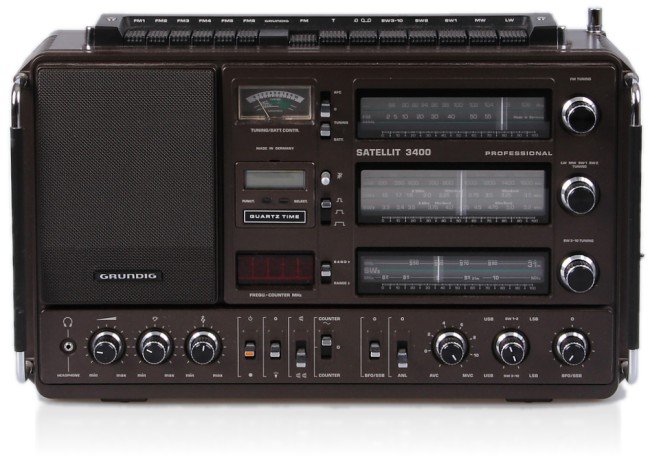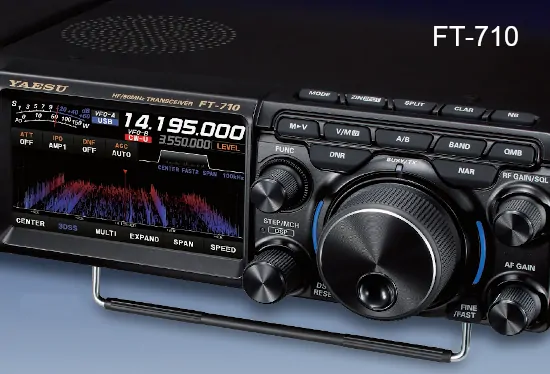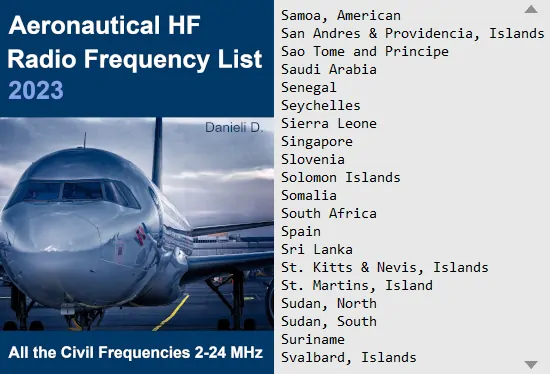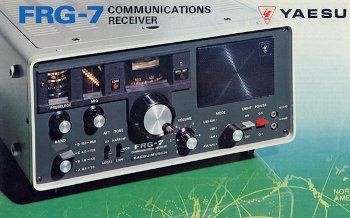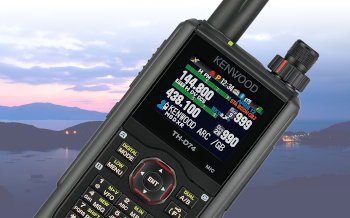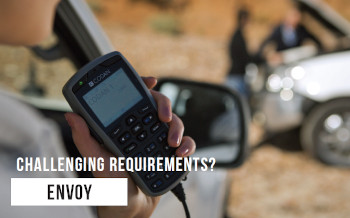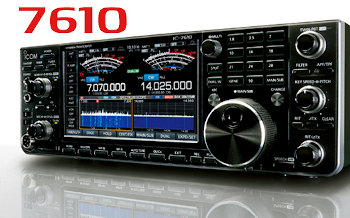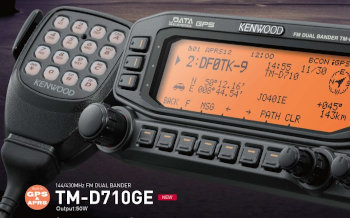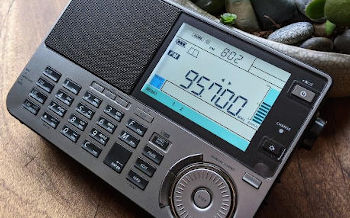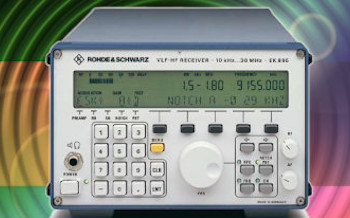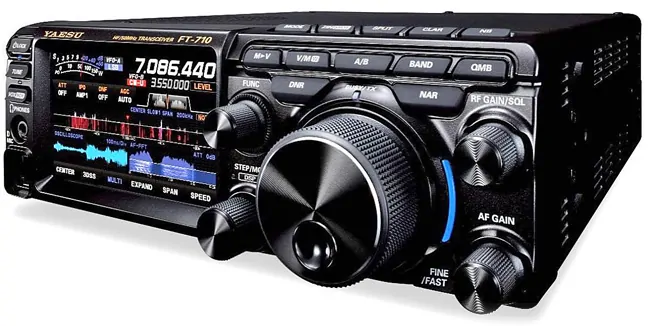
HF / 50 / 70 MHz compact direct-sampling SDR Transceiver with powerful RF Front-End and Low Noise Oscillator for High-Performance Multi-Signal receiving characteristics. AESS (Acoustic Enhancement Speaker System) for high-fidelity audio. Twin A/D converter circuit configuration, 113dB RMDR @ 2 kHz, 127dB Blocking @ 2 kHz, high-speed dual-core DSP. 3DSS 4.3-inch (10.9cm) color Touch Panel display. Oscilloscope and RF spectrum scope (3D, waterfall). The filter display show AF spectrum as well as the operation status of the interference reduction functions. 5 to 100 Watt power output, built-in ATU. Two USB ports, SD-card slot, external Display connection. Ideated in Japan, year of introduction 2022.
Reference market : amateur-radio
FT-710 specifications
| General |
| Frequency coverage | |
|---|---|
| Receive | 0.0300 ~ 75.0000 MHz [1] |
| Transmit | 1.8 / 3.5 / 5.1675 [2] / 5.3 / 7 / 10 / 14 / 18 / 21 / 24 / 28 / 50 / 70 [3] MHz band |
| Mode | |
| CW / FSK / PSK / LSB / USB / AM / FM | |
| Tuning step | |
| 1 / 5 / 10 / 20 / 100 Hz / 1 / 2.5 / 5 / 6.25 / 9 / 10 / 12.5 / 20 / 25 kHz / 1 MHz | |
| Receiver |
| Sensitivity | |
|---|---|
| SSB / CW [4] | 0.16 uV (1.8~30 MHz, 10dB S+N/N, IPO: AMP2) 0.125 uV (50~54 MHz, 10dB S+N/N, IPO: AMP2) 0.16 uV (70~70.5 MHz, 10dB S+N/N, IPO: AMP2) |
| AM [5] | 6.3 uV (0.5~1.8 MHz, 10dB S+N/N) 2 uV (1.8~30 MHz, 10dB S+N/N, IPO: AMP2) 1 uV (50~54 MHz, 10dB S+N/N, IPO: AMP2) 2 uV (70~70.5 MHz, 10dB S+N/N, IPO: AMP2) |
| FM [6] | 0.25 uV (28~30 MHz, 12dB SINAD, IPO: AMP2) 0.2 uV (50~54 MHz, 12dB SINAD, IPO: AMP2) 0.25 uV (70~70.5 MHz, 12dB SINAD, IPO: AMP2) |
| Selectivity [7] | |
| CW | > 0.50 KHz (-6dB)
< 0.75 KHz (-60dB) |
| SSB | > 2.4 KHz (-6dB)
< 3.6 KHz (-60dB) |
| AM | > 6 KHz (-6dB)
< 15 KHz (-60dB) |
| FM | > 12 KHz (-6dB)
< 25 KHz (-60dB) |
| RF preamplifiers | |
| AMP1 | ~10 dB |
| AMP2 | ~20 dB |
| RF attenuator | |
| 6 / 12 / 18 dB | |
| IMDR (3rd Intermodulation Dynamic Range) | |
| 102 dB (2 KHz spaced signals, 14 MHz) 103 dB (20 KHz spaced signals, 14 MHz) 103 dB (100 KHz spaced signals, 14 MHz) |
|
| RMDR (Reciprocal Mixing Dynamic Range) | |
| 113 dB (2 KHz spaced signals, 14 MHz) 121 dB (20 KHz spaced signals, 14 MHz) 124 dB (100 KHz spaced signals, 14 MHz) |
|
| Blocking | |
| 127 dB (2 KHz spaced signal, 14 MHz) 128 dB (20 KHz spaced signal, 14 MHz) 128 dB (100 KHz spaced signal, 14 MHz) |
|
| Synthesizer phase noise | |
| -143 dBc @ 2 KHz (14 MHz) -148 dBc @ 20 KHz (14 MHz) |
|
| Image rejection | |
| > 70 dB (1.8~30 MHz, amateur bands) > 60 dB (50~54 MHz, amateur band) |
|
| Notch filter | |
| Manual | Yes, 10~3200 Hz adjustable |
| Automatic | Yes |
| NB (Noise Blanker) | |
| Yes, level/attenuation/width adjustable | |
| DNR (Digital Noise Reduction) | |
| Yes, 15 profiles | |
| AGC (Automatic Gain Control) | |
| Fast / mid / slow (time constant adjustable) | |
| Frequency stability | |
| ± 0.5 ppm max with temperature from 0°C to +50°C after 1' warm-up | |
| IF (Intermediate Frequency) [8] | |
| 1° | 18 kHz (CW / SSB) 24 kHz (AM / FM) |
| CW features | |
| Auto zero-in Zero-in display Pitch control Reverse mode L/USB Semi break-in / full break-in APF filter, narrow/medium/wide |
|
| FT8 features | |
| One-touch preset | |
| FSK features | |
| Normal or Reverse Mark frequency 2125 or 1275 Hz Shift 170, 200, 425 or 850 Hz |
|
| Transmitter |
| Output power | |
|---|---|
| HF / 50 MHz | 5 ~ 100 W (SSB / CW / FSK / PSK / FM). 5 ~ 25 W (AM). |
| 70 MHz | 5 ~ 50 W (SSB / CW / FSK / PSK / FM). 5 ~ 25 W (AM). |
| Spurious emission | |
| Harmonics | < -50 dB (1.8~29.7 MHz, amateur bands) < -63 dB (50 MHz, amateur band) |
| Carrier suppression (SSB) | |
| > 60 dB | |
| Unwanted sideband suppression (SSB) | |
| > 60 dB | |
| Maximum deviation (FM) | |
| ±5 / ±2.5 KHz | |
| Occupied bandwidth (FM) | |
| 16 kHz | |
| Occupied bandwidth (AM) | |
| 6 kHz | |
| Occupied bandwidth (SSB) | |
| 3 kHz | |
| Audio response (SSB) | |
| 300~2700 Hz @ -6dB | |
| Microphone | |
| 600Ω (200 to 10kΩ) | |
| CW features | |
| Straight/Bug/ACS keyer mode 4~60 wpm keyer speed Normal/Reverse keyer polarity 2.5~4.5 dot/dash ratio 5 memory channel, up to 50 characters |
|
| Antenna tuner | |
| Impedance range | 16-150Ω (1.8~29.7 MHz, amateur bands) 25-100Ω (50 MHz, amateur band) |
| Features |
| Memory | |
|---|---|
| 99 regular memories, 5 groups
9 pairs for PMS 3 band-stack memories 10 quick memory bank |
|
| Display | |
| 4.3-inch (10.9cm) TFT color touch panel.
1 Hz frequency resolution |
|
| Selective calling | |
| CTCSS 50-subtones | |
| Antenna | |
| SO239 50Ω | |
| Power supply | |
| 13.8 VDC ±15% | |
| Power consumption | |
| 1.8A RX, no signal 2.2A RX, signal present 21A TX, 100W power |
|
| Audio power | |
| 2.5 W on 4Ω | |
| Audio output | |
| Jack 3.5 mm headphone
Jack 3.5 mm external speaker (4~16Ω) |
|
| Connections | |
| Jack 3.5 mm (key) Jack (FH-2 remote control keypad / ALC) 6-pin Jack (TNC) 8-pin Jack (antenna tuner / power amplifier) 8-pin Jack (MIC) USB B-type (PC) USB A-type (keyboard / mouse) DVI-D (external display) |
| Mechanical and environmental data |
| Operating temperature | |
|---|---|
| from 0°C to +50°C | |
| Dimensions | |
| 239 (W) x 80 (H) x 247 (D) mm | |
| Weight | |
| 4.5kg |
- 1.8 to 29.7, 50 to 54, 70 to 70.5 MHz specified performance. Amateur bands only.
- U.S. version only. Operation on Alaska emergency frequency.
- U.K. version. Amateur bands only.
- 2.4 kHz bandwidth.
- 6 KHz bandwidth.
- 12 KHz bandwidth.
- Adjustable.
- Direct-sampling superheterodyne, SDR with digital low-IF.

Updated | Complete | UK - NORTHERN IRELAND
378 pages | 300+ Airports and Airfields
Voice com. | ACC | FIC | VOLMET | ACARS | VDL | ILS | VOR | DME
Yaesu FT-710 Software Defined Radio circuit configuration emphasizes receiving performance. The rig is equipped with the same high-resolution A/D converter and FPGA used in Yaesu high-end SDR transceivers. The twin Analog-to-Digital converter circuit configuration performs digital conversion processing using two A/D unit. The digital signal is combined by the FPGA to reduce overload and overflow of the A/D converters and improve blocking characteristics. In addition, random noise is added to the analog signal before digital conversion, distortion is suppressed by minimizing the quantization error during conversion by the Analog-to-Digital converter, and a dithering technology that improves intermodulation characteristics is adopted. The overall performance of the SDR receiving circuit is superb.

Yaesu FT-710 receiver block diagram
FT-710 dynamic range :
Powerful RF Front-End and Low Noise Oscillator System enable phenomenal multi-signal receiving characteristics. The Band-Pass filter in the amateur bands as well as the RF amplifier, are excellent in intermodulation characteristics. A low Noise figure is adopted in the front-end section. Additionally, high resolution 250 MHz High Resolution Direct Digital Synthesizer (HRDDS) circuit configuration is used, it is possible to supply a high-quality sampling clock signal with excellent C/N characteristics to the A/D converter. While the FT-710 is compact, it boasts proximity multi-signal characteristics comparable to the high-end transceivers. Also in the transmitter section, excellent C/N characteristics and low noise are thoroughly pursued by the high quality clock signal from HRDDS.
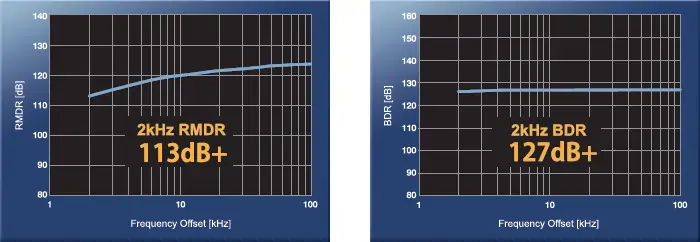
Yaesu FT-710 14 MHz RMDR - Reciprocal Mixing Dynamic Range (left) and BDR - Blocking Dynamic Range (right)
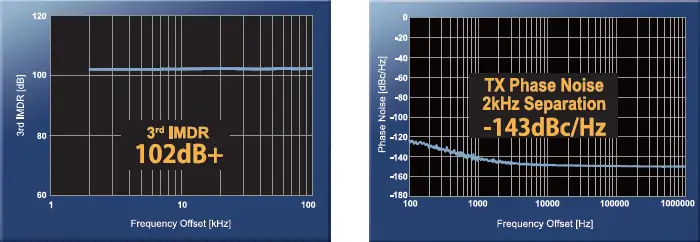
Yaesu FT-710 14 MHz IMDR - 3rd Intermodulation Dynamic Range (left) and TX Phase Noise at 100 Watt (right)
More, two selectable RF stages amplify the desired signals from low band to high band. Preamplifier AMP1, and AMP2 are low noise negative feedback RF amplifiers that may be selected or combined in series as is needed for various low-band, high-band, frequency and noise conditions. In addition, the IPO (Intercept Point Optimization) function maximizes the dynamic range and enhances the close multi-signal and IM characteristics of the receiver. The influence of strong broadcasting stations, especially in the low bands as 80 and 40m, can be minimized.
FT-710 DSP system :
Effective QRM rejection is afforded by high-speed Digital Signal Processing. The Dual core 32-bit high speed floating decimal point DSP (Clock at 594 / 198 MHz) produced by NXP, is used. Yaesu's effective Interference Reduction Systems: SHIFT, WIDTH, NOTCH, CONTOUR, APF, DNR, NB are performed by high-speed digital processing. The interference functions are all accessed from the DSP dial. The filter display shows pass-band AF spectrum information as well as the operation status of the interference reduction functions.

Yaesu FT-710 SHIFT (left) and WIDTH (right) display

Yaesu FT-710 NOTCH (left) and CONTOUR (right) display
In the upper part of the main display, a filter function display presents the state of the pass-band. In addition to the operating state of the interference removal functions, the filter function information is displayed. Not only can you grasp the operating status of Width, Shift, Notch and Contour at a glance, you can also view the status of the RF spectrum in the passband.
The Width feature allows the bandwidth (BW) to be narrowed, while the Shift feature can eliminate interference in one side of the passband. Often, weak signals disappear due to interfering signals. The interfering signals may be extracted, leaving only the desired signal, because of the unique DSP sharp filtering characteristics. More, rather than using the DSP extremely sharp attenuation characteristics, the Contour circuit provides gentle shaping of the DSP passband filter. Thus attenuate or peak bandwidth components in segments. The interfering signal can be naturally shaped without having part of the signal suddenly disrupted. The contour function is very effective in making the desired signal rise out of the interference.
FT-710 AESS system :
AESS (Acoustic Enhancement Speaker System) produces high-fidelity audio using DSP signal processing. The speaker in the top of the Transceiver, and an external side speaker (SP-40 speaker, supplied accessory) are combined to reproduce high-quality received audio with a wide frequency range and a three-dimensional effect that would not be expected from a compact HF transceiver. set the optimum sound quality by adjusting the output balance and frequency characteristics of the two speakers according to your preference.
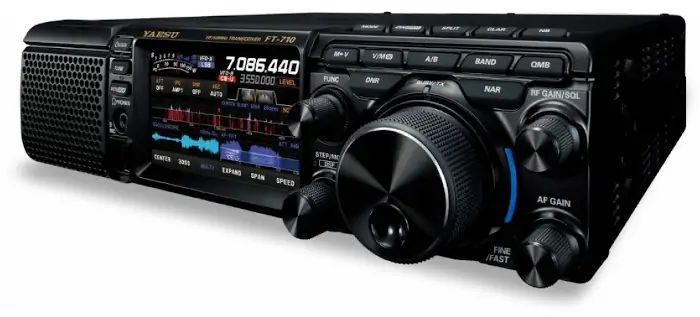
Yaesu FT-710 with the SP-40 supplied speaker
FT-710 front panel design :
Compact Transceiver, yet a large 4.3-inch (10.9cm) color touch panel display provides intuitive operation and outstanding visibility. Primary operating functions are arranged on the front and centered above the VFO dial for operating efficiency and instant access.

Yaesu FT-710, designed for operating efficiency and comfort
Large size VMI (VFO mode indicator) LED indicators are placed on the left and right of the VFO dial to show the current operating modes at a glance. VMI assists smooth operation and error free tuning. The color of the VMI indicator may be selected from 4 colors (blue, green, red, white) for each operation status.

Yaesu FT-710 VMI indicators, from left: VFO-A, VFO-B, Memory mode, Clarifier/Split operation
The FUNC knob. Simply press the knob to easily select the setting menu, and then change the setting value. A function or setting menu that is used frequently may be assigned, so it can be accessed quickly and the setting made by simply turning the knob.
The QMB (Quick Memory Bank) function can be used to store up to 10 dedicated memory channels. With one touch a memory can easily be recalled. The Quick Memory Bank stores the frequency, the mode, transmit and receive settings, filters and other parameters, so operating may begin quickly in the best condition without re-setting, when switching bands. Memory settings can be easily checked by listing the memory contents on the display.
SD Memory Card slot. Use a commercially available SD Card to record and save the FT-710 settings, the memory contents, recording/playback of received audio, for voice recording for transmission, and screen capture images. The SD Card is also used to update the firmware.
The wide full-color touch panel display, affords intuitive management of operating frequency, meters and main function settings. The real-time spectrum scope display adopts the FTDX series (FT-DX10 and FT-DX101) scope 3DSS to visualize changes in signal strengths within the bands. The 3DSS image uses the horizontal axis (X axis) for frequency, the vertical axis (Y axis) for signal intensity, and the Z axis for time. Compared to the conventional waterfall method, the signal strength is displayed in three dimensions as well as in color, recognition of changes in the band conditions is instant, convenient and intuitive. Scope specifications: sweep speed 30 FPS, range 100 dB, span width 1-1000 kHz.
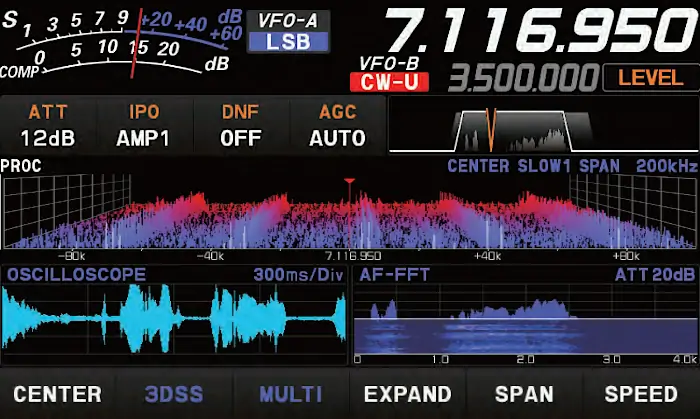
Yaesu FT-710 high-resolution Display with 3DSS
The Multi function display mode alows the oscilloscope and the AF-FFT audio scope to be shown on the screen, in addition to the RF spectrum scope display. In Multi display, while monitoring the receive band, a simultaneous view of the contact station's transmit signal audio characteristics can be viewed with the AF-FFT function. At the same time the receiver filter and interference reduction functions can be observed on the Multi display for their influence on the received signal.
An external digital video output terminal (DVI-D) is furnished on the rear panel. Directly connect to an external display using a commercially available cable, without need of the LAN connection or other unit. It enables video operation and communication such as projecting the detailed band conditions or filter settings by a High-resolution large screen monitor.
FT-710 FT8 ready :
The multiple settings required for FT8 operation may be set with one touch of PRESET. The Preset item settings can be called and customized by pressing and holding the display button. It is possible to save up to 5 preset parameters.
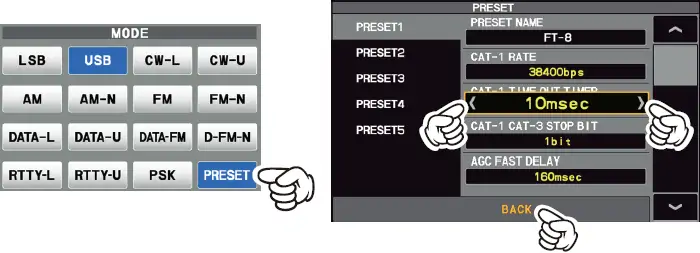
Yaesu FT-710 Preset setting, the FT8 easy way
FT-710 microphone equalizer :
The Yaesu FT710 includes a unique Three-Band Parametric Microphone Equalizer that provides precise, independent control over the low, mid and treble ranges in the voice waveform. One group of settings may be utilized when the AMC (Automatic Microphone Gain control) or speech processor is Off, and an alternate group of settings when the AMC or Speech Processor is On in SSB mode.

Yaesu FT-710 Parametric Microphone Equalizer range
As parametric equalizer the center frequency of each of the three bands, the amount of enhancement or suppression (gain) within each band, and the bandwidth (Q) over which the equalization is applied may be adjusted.
FT-710 60m band :
Memory channels (USA version: channel 5-01 through 5-15) are preprogrammed, at the factory, with the permitted frequencies in the 5 MHz band, and the USB or CW mode is automatically selected on these channels. See table.
| Channel number | Frequency | Mode |
|---|---|---|
| 5-01 | 5.332,0 MHz | USB |
| 5-02 | 5.348,0 MHz | USB |
| 5-03 | 5.358,5 MHz | USB |
| 5-04 | 5.373,0 MHz | USB |
| 5-05 | 5.405,0 MHz | USB |
| 5-06 | 5.332,0 MHz | CW-U |
| 5-07 | 5.348,0 MHz | CW-U |
| 5-08 | 5.358,5 MHz | CW-U |
| 5-09 | 5.373,0 MHz | CW-U |
| 5-10 | 5-405,0 MHz | CW-U |
| 5-11 | 5-332,0 MHz | DATA-U |
| 5-12 | 5.348,0 MHz | DATA-U |
| 5-13 | 5.358,5 MHz | DATA-U |
| 5-14 | 5.373,0 MHz | DATA-U |
| 5-15 | 5.405,0 MHz | DATA-U |
FT-710 rear panel and connections :
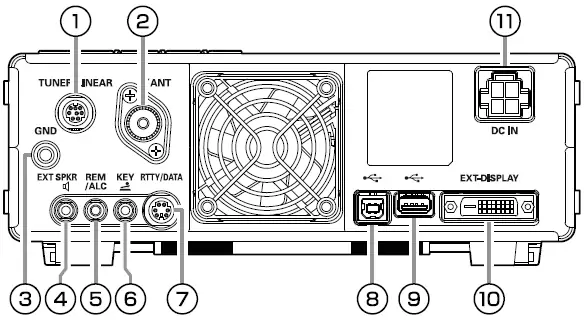
Yaesu FT-710 rear panel and connections
| Reference / Description | |
|---|---|
| 1 | TUNER / LINEAR This 8-pin output jack is used to connect to the FC-40 External Automatic Antenna Tuner or a Linear Amplifier. |
| 2 | ANT Antenna, PL-259 connector. The internal antenna tuner affects only the antenna connected here, and only during transmission. |
| 3 | GND Use this terminal to connect the transceiver to a good earth ground, for safety and optimal performance. |
| 4 | EXT SPKR This 3.5mm, two-contact (mono), jack provides audio output for a supplied external loudspeaker SP-40. The impedance at the jack is 4-8Ω. |
| 5 | REM / ALC By plugging the FH-2 Remote Control Keypad into this jack, direct access to the transceiver CPU is provided for control functions of the contest memory keying, and also frequency and function control. When a device such as a linear amplifier is connected, this is an external ALC current input jack. |
| 6 | KEY This 3.5mm, three-contact, jack accepts a CW key or keyer paddle. A two-contact plug cannot be used in this jack. Key-up voltage is +5V DC, and key-down current is 3mA. |
| 7 | RTTY / DATA This 6-pin jack accepts AFSK input from a TNC, it also provides fixed level receiver audio output, and FSK keying line. |
| 8 | USB Connecting to a PC from this jack with a USB cable allows remote control by CAT commands. The jack can also be used for input and output of audio signals and transmitter control. A USB driver is required for remote control from a PC, free from the Yaesu website. |
| 9 | USB Connect a USB A-type keyboard or mouse. They can be used to select items on the screen or to enter characters. |
| 10 | EXT DISPLAY DVl-D connector for connecting an external monitor, 800 x 480 or 800 x 600 resolution. When using an external monitor, set the setting menu item EXT-DISPLAY to On. |
| 11 | DC IN This is the DC power supply connection for the transceiver. |
FT-710 price
We have collected for your convenience the Yaesu FT710 sale price (Euro) and its trend over time. Useful to guarantee a cheaper purchase of this radio and to put it for sale in the second-hand market. Of course offers, accessories, warranty terms and conditions can lead to different figures.
|
|
|
|
| EUR 1139.00 | 2023-mar | Brand-new |
| EUR 1144.90 | 2022-sep | Brand-new |
FT-710 review
| F6IHJ | 26 March 2024 |
I have been using my FT710 for 6 months, generally satisfactory, I have noted a few points that could be improved:
In CW reception the signal transition is poorly managed, the AGC in AUTO mode or in FAST mode does not change anything, you have to lower the RF Gain on strong signals so that the sound is not distorted...
CW really lacks a quartz filter to reinforce the narrow digital filtering. The sound volume of the keyer is not managed by the volume button and required to enter the menu. In transmission, the power control and WPM of the keyer are missing on the front panel.
It is very good in speech, after spending time with the settings, a DX and local pre-set would be welcome accessible on the front panel.
[End post]
Your opinion on merits, defects, experiences, with this radio set is welcome. Write your review, after a technical evaluation by our staff if found suitable will be published on this page. We thank you for your precious contribution.
